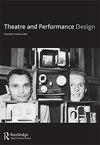Editors’ introduction
Q2 Arts and Humanities
引用次数: 0
Abstract
Chris Salter, Guest Editor of this special double issue of Theatre and Performance Design, has long observed and analysed the ‘entanglement’ of technology and performance histories and practices (Salter 2010) and made visible the degree of (invisible) surveillance with which ‘sensing machines’ have infiltrated our daily work and life (Salter 2022). In the call for ‘On Capture’, Salter again focussed on surveillance, yet this time with a focus on performative bodily and scenographic practices and the way in which artists interpret and realise ‘capture’ on the stage and in the studio, and how key parameters of performance (body, time, space) are represented, altered and critiqued through the encoding and decoding of data in live and mediated performance. The timeliness of this issue is also its urgency. As relentless reports on the rapid development and expansion of the properties of publicfacing artificial intelligence (AI) systems unfold, an ambivalence towards our fascination with technology comes to the fore. Is the deliberate slowing down of AI research and development justified to establish ethical strategies to deal with its purported limitless knowledge production and communication, as some suggest? Is a certain techno-pessimism the natural consequence of being confronted with a technology that may erase us? On the other hand, rather than dominate or erase, the call by psychologists and neurobiologists for AI to develop so-called ‘hot’ cognition (Cuzzolin et al. 2020) – that is, to understand and react to a person’s thinking, including the concept of Theory of Mind (ToM) – may just be beginning to be answered by the most recent research. ToM denotes a person’s ability to take another person’s perspective in communication, and whether or not AI has ToM is hotly disputed right now (Whang 2023). If, however, an AI system is equipped with ToM, it not only will understand humans’ thinking but will also be able to understand that of another, similar AI system. This will mean robot-to-robot performances, as well as human and robot ones, will be able to not only simulate ToM and related qualities such as empathy but will actually embody these in real time, opening up myriad perspectives and concerns for artists at the same time. In line with the above thoughts, the responses to Salter’s call by practitioners and theorists demonstrate a deep engagement with creating new (and different) relationships and new (and different) production and reception aesthetics forged from the confrontation between the physical body and binary data. The depersonalisation of the actor’s body, evoked since Kleist and Maeterlinck and revisited by Craig in his concept of the Übermarionette, and its subsequent re-personalisation in a ‘datafied’ theatrical environment and, with it, the processes of de-theatricalisation and re-theatricalisation of the stage are some of the aspects prevalent in this issue. These deconstruct and redefine, often in experimental settings, key issues of identity and mimesis, of presentation and representation in performance (theory). Dedicated to artists’ and theorists’ diverse practices of interrogating, expanding, pushing, and contextualising existing and new technologies of data capture in scenography and performance, ‘On Capture’ shows that humans and more-than-humans will not only exist side by side but rather evolve together, in both synchronous and dissonant ways. For a journal such as ours, this means that the discourse on technology, body and space in the expanded编辑的介绍
克里斯·索尔特(Chris Salter)是《戏剧与表演设计》特刊的客座编辑,他长期观察和分析了技术与表演历史和实践的“纠缠”(Salter 2010),并使“传感机器”渗透到我们日常工作和生活中的监控程度(无形)变得可见(Salter 2022)。在“捕捉”的呼吁中,索尔特再次关注监视,但这一次的重点是表演身体和场景实践,以及艺术家在舞台和工作室中解释和实现“捕捉”的方式,以及表演的关键参数(身体,时间,空间)如何通过现场和中介表演中的数据编码和解码来表现,改变和批评。这个问题的及时性也是它的紧迫性。随着关于面向公众的人工智能(AI)系统属性快速发展和扩展的无情报道的展开,对我们对技术的迷恋的矛盾心理浮出水面。像一些人建议的那样,故意放慢人工智能的研发速度,以建立道德战略来应对其所谓的无限知识生产和交流,这是否合理?某种技术悲观主义是面对一种可能消灭我们的技术时的自然结果吗?另一方面,心理学家和神经生物学家呼吁人工智能发展所谓的“热”认知(Cuzzolin et al. 2020),即理解并对一个人的思维做出反应,包括心智理论(ToM)的概念,而不是主导或消除,最近的研究可能刚刚开始回答。ToM指的是一个人在交流中站在另一个人的角度看问题的能力,而人工智能是否拥有ToM目前是一个备受争议的问题(Whang 2023)。然而,如果一个人工智能系统配备了ToM,它不仅能理解人类的思维,还能理解另一个类似的人工智能系统的思维。这将意味着机器人对机器人的表演,以及人类和机器人的表演,不仅能够模拟ToM和相关的品质,如移情,而且能够实时地体现这些品质,同时为艺术家们开辟了无数的视角和关注点。与上述思想一致,实践者和理论家对索尔特呼吁的回应显示出一种深刻的参与,即创造新的(和不同的)关系,以及从物理身体和二进制数据之间的对抗中锻造出的新的(和不同的)生产和接受美学。演员身体的去人格化,自克莱斯特和梅特林克引起,克雷格在他的Übermarionette概念中重新审视,以及随后在“数据化”戏剧环境中的再人格化,与此同时,舞台的去戏剧化和再戏剧化的过程是这个问题中普遍存在的一些方面。这些解构和重新定义,通常在实验设置,身份和模仿的关键问题,表现和表现(理论)。“关于捕捉”展示了艺术家和理论家对现有的和新的数据捕捉技术的质疑、扩展、推动和语境化的不同实践,展示了人类和超越人类不仅会共存,而且会以同步和不和谐的方式共同进化。对于像我们这样的期刊来说,这意味着关于技术、身体和空间的论述在扩大
本文章由计算机程序翻译,如有差异,请以英文原文为准。
求助全文
约1分钟内获得全文
求助全文
来源期刊

Theatre and Performance Design
Arts and Humanities-Visual Arts and Performing Arts
CiteScore
0.40
自引率
0.00%
发文量
14
 求助内容:
求助内容: 应助结果提醒方式:
应助结果提醒方式:


